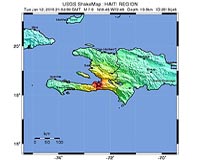| . |  |
. |
Port-Au-Prince (AFP) Jan 24, 2010 Less than one month before Haiti's devastating earthquake, geologist Claude Prepetit gave the latest in a string of warnings that the "big one" was coming. No one listened. But now he has a fresh message for the authorities after 20 years of shouting into the void -- evacuate Port-au-Prince or risk another disaster on scale of the January 12 quake which killed at least 150,000 people. "We are sitting on a powder keg," Prepetit, an engineer from the Haitian Mines and Energy bureau, told AFP. "We are faced with the threat of future earthquakes and have to decentralize, and depopulate Port-au-Prince." Prepetit said in an article in the Haitian newspaper Le Nouvelliste less than a month before the quake that "we have entered an apparent lull during which the energy has continued to accumulate in the ground, and the day when it cracks the consequences will be catastrophic for the region." For years he has pushed his ideas at schools, universities and conferences, explaining the slow shearing of the American and Caribbean continental shelves which made the tremor inevitable. "Even in Los Angeles they are waiting for the big one but they don't know when," he says. He pushed in vain for the government to buy seismological equipment capable of detecting the movements imperceptible to humans that would precede a big quake. "The government listened to me but they had other priorities," he said, referring to the meager resources available to the authorities of the poorest nation in the Americas. The last catastrophic earthquake to hit Port-au-Prince was in 1770, and with the tectonic plates moving by seven milimetres a year along the so-called Enriquillo-Plantain Garden fault, "over 240 years, that means there is a 1.4-metre (yard) gap to make up," he said. "It's simple mathematics: a rupture of that size corresponds to a 7.3-magnitude quake," he said. The quake that eventually hit was 7.0. While the US Geological Survey says there is a 25 percent risk of aftershocks of a magnitude of 6.0 for a month after the quake, Prepetit is worried that 250-kilometre (403-mile) fault there has been not ruptured to the east of the capital, with only about a fifth of its length having cracked. He fears the rupture could repeat in the north of the country, where there is another fault just below the town of Cap Haitien, home to 300,000 people. Faced with these risks, Prepetit believes that the government "must depopulate Port-au-Prince, where there are two million people, 26 percent of the Haitian population" and move them onto dozens of shantytowns on 500 square kilometres of designated safe ground outside the capital. "It is necessary to think of Haiti as a whole and not just of the 'republic of Port-au-Prince.' It is necessary to take time to rebuild the capital and to locate people in the provinces, while creating infrastructure and jobs to keep them there," he said. Priorities also include improving construction standards, which are non-existent in the capital, and educating a population that is familiar with hurricanes and floods but has long forgotten the risk of earthquakes. "Education can save people, and ignorance can kill," Prepetit said. When his house started to shake like a leaf on January 12 the geologist had his wits about him and took shelter beneath a doorframe, he says. But he admitted that during those 16 seconds which seemed to last an eternity he said that he, like millions of other Haitians, ended up praying: "No, my God, no!"
Related Links Tectonic Science and News
 Haiti Quake Occurred In Complex Active Seismic Region
Haiti Quake Occurred In Complex Active Seismic RegionWoods Hole MA (SPX) Jan 21, 2010 The magnitude 7.0 earthquake that triggered disastrous destruction and mounting death tolls in Haiti this week occurred in a highly complex tangle of tectonic faults near the intersection of the Caribbean and North American crustal plates, according to a quake expert at the Woods Hole Oceanographic Institution (WHOI) who has studied faults in the region and throughout the world. Jian Lin ... read more |
|
| The content herein, unless otherwise known to be public domain, are Copyright 1995-2009 - SpaceDaily. AFP and UPI Wire Stories are copyright Agence France-Presse and United Press International. ESA Portal Reports are copyright European Space Agency. All NASA sourced material is public domain. Additional copyrights may apply in whole or part to other bona fide parties. Advertising does not imply endorsement,agreement or approval of any opinions, statements or information provided by SpaceDaily on any Web page published or hosted by SpaceDaily. Privacy Statement |